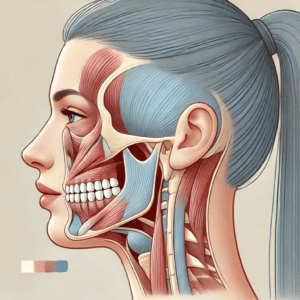Headache Types by Location: What Your Headache Is Trying to Tell You Based on Pain Area
Table of Contents

Headache Types by Location: What Your Headache Is Trying to Tell You Based on Pain Area 🤕
Ever wonder why your headache always hits the same spot?
Like why that tight band around your forehead always shows up on stressful days? Or why you wake up with throbbing pain behind your eyes?
Understanding the location of your headache can be a powerful clue. It often points to the underlying cause — whether it’s tension, sinus pressure, a jaw issue, or even something more serious.
Let’s decode your pain map together. Here’s what each type of headache location may be telling you 🧠👇
👤 Frontal Headache (Forehead & Behind Eyes)
What It Feels Like:
- Pressure or dull ache in the forehead
- Pain behind the eyes or eyebrows
- Worse when leaning forward
Likely Causes:
- Tension Headache – Most common type, triggered by stress or screen use
- Sinus Headache – Due to sinus infection or allergies
- Eyestrain – Poor lighting or incorrect prescription glasses
🧠 Pro Tip: If it gets worse in the morning or with bending, suspect sinus congestion.
🏹 Temporal Headache (Sides of the Head)
What It Feels Like:
- Aching, pulsing, or throbbing near the temples
- Can be one-sided or both sides
- Sometimes sharp or burning
Likely Causes:
- Tension-Type Headache
- TMJ Disorder – Jaw clenching or grinding
- Migraine – If accompanied by nausea, aura, or sensitivity to light/sound
- Temporal Arteritis – A rare condition in older adults that causes temple tenderness
🚨 When to worry: If temple pain is severe in someone over 50 with vision changes — seek urgent care to rule out giant cell arteritis.
💢 Occipital Headache (Back of the Head & Neck)
What It Feels Like:
- Pain at the base of the skull or radiating up
- Tenderness in the neck muscles
- May spread to behind the eyes
Likely Causes:
- Occipital Neuralgia – Irritation of occipital nerves
- Cervicogenic Headache – Triggered by neck injury or posture
- Tension Headache – Especially with tight shoulders
🧠 Tip: Poor posture at your desk or grinding your teeth can trigger this kind of pain.
🔥 Periorbital / Retro-orbital Headache (Around or Behind One Eye)
What It Feels Like:
- Sharp, stabbing pain around or behind one eye
- Usually one-sided and cyclical
- May come with redness, tearing, or nasal congestion
Likely Causes:
- Cluster Headache – Nicknamed “suicide headaches,” extremely painful
- Migraine – Especially in women, often throbbing and paired with aura
- Optic Neuritis or Glaucoma – If sudden vision changes occur
🚨 Red flag: Sudden onset eye pain with vision loss = emergency.
😣 Facial or Jaw Pain Headache (Cheeks, Jaw, or Ear)
What It Feels Like:
- Pain in the cheeks, jaw, ears, or temples
- Clicking or popping jaw
- Worse with chewing or talking
Likely Causes:
- Temporomandibular Joint Disorder (TMJ/TMD)
- Trigeminal Neuralgia – Electric shock-like pain
- Dental Issues – Infections, grinding, or malocclusion
🦷 Clue: If it hurts more when eating or opening your mouth wide, suspect TMJ-related headache.
🧠 Vertex Headache (Top of the Head)
What It Feels Like:
- Pressure or tightness on the crown of the head
- Like wearing a tight helmet
- May feel like a weight on the top of your head
Likely Causes:
- Tension-Type Headache
- Cervicogenic Headache
- Migraines
👀 Note: Top-of-head pain can be tricky — often due to referred pain from the neck.
📊 Summary: Headache Types by Location
| Headache Location | Possible Causes |
|---|---|
| Forehead / Behind Eyes | Tension, sinus, eyestrain |
| Temples | Tension, migraine, TMJ, temporal arteritis |
| Back of Head / Neck | Occipital neuralgia, tension, cervicogenic |
| Behind One Eye | Cluster, migraine, optic issues |
| Face / Jaw | TMJ, dental, trigeminal neuralgia |
| Top of Head | Tension, migraine, posture-related |
🌟 Conclusion: What Your Headache Location Might Mean
Knowing where your headache hits gives you a huge head start on figuring out why it happens.
- Tension? It’s often bilateral and pressure-like.
- Migraine? Usually throbbing and one-sided.
- TMJ? Jaw pain + headaches = big clue.
- Cluster? Eye-piercing, rhythmic attacks.
✨ Bottom line: The location of your headache is a map. Learning to read it can help you treat it smarter, faster, and with fewer meds.
But remember: if the headache is new, intense, or unusual — see a doctor.
❓ FAQ
1. Can the location of a headache diagnose it?
Not always, but it gives important clues. Full diagnosis includes duration, severity, triggers, and response to treatment.
2. Is temple pain always migraine?
No. It could be tension, TMJ, or even vascular issues like temporal arteritis.
3. Why does my headache move around?
Some headaches (like tension-type) can shift locations. Others (like cluster or trigeminal neuralgia) are more fixed.
4. What headache location is most serious?
Sudden, severe pain at the base of the skull or behind one eye with vision loss can signal a medical emergency.
5. Should I get imaging for recurring headaches?
Not always. But if headaches are new, worsening, or come with red flags (neurological symptoms), your doctor may order an MRI or CT scan.













Post Comment